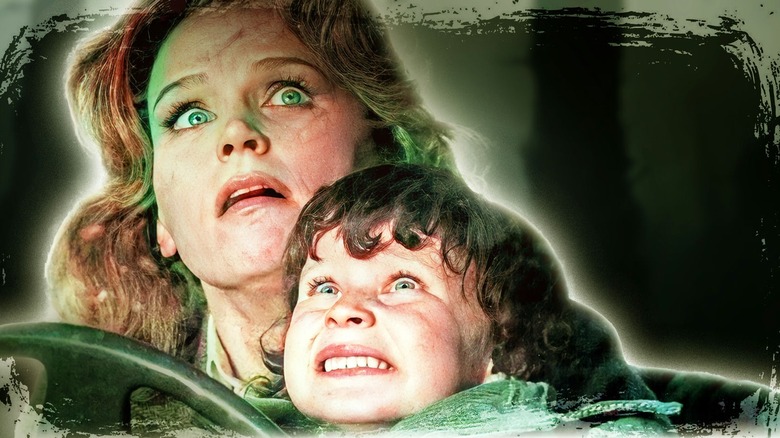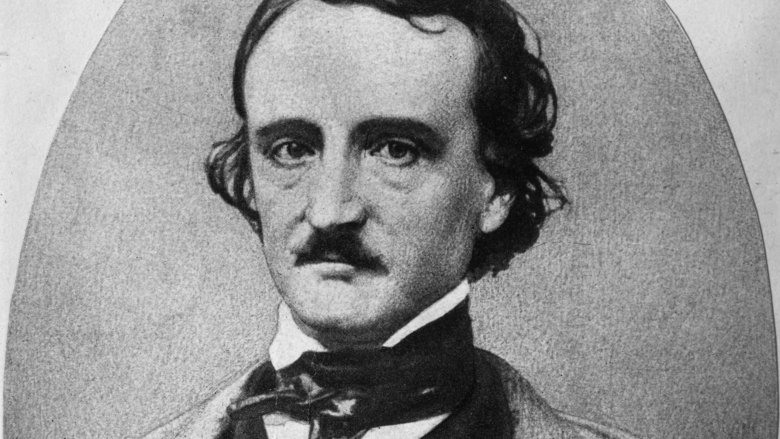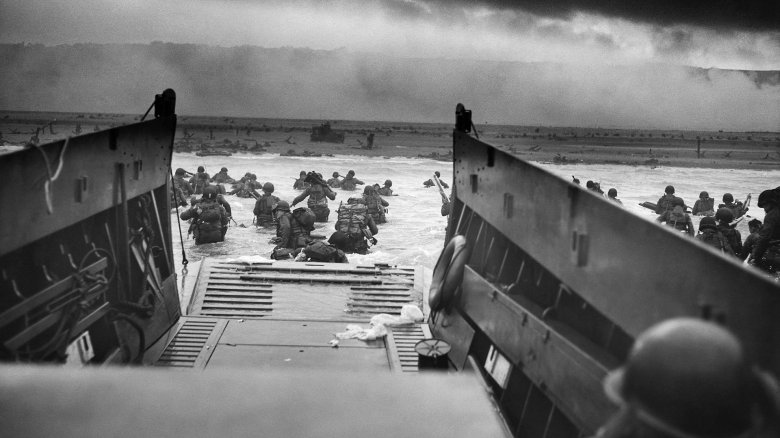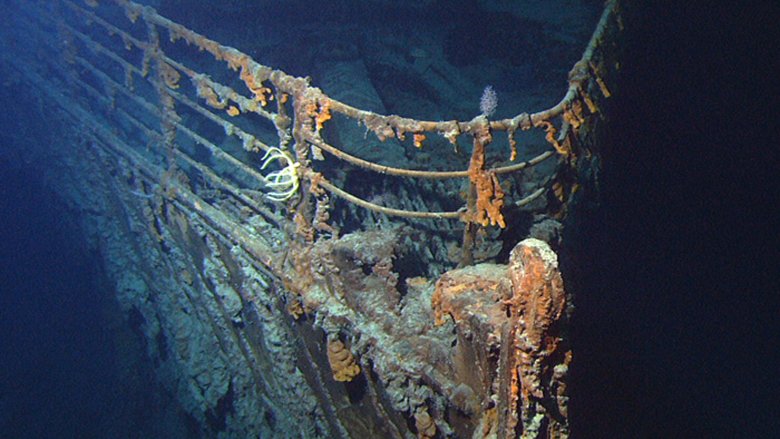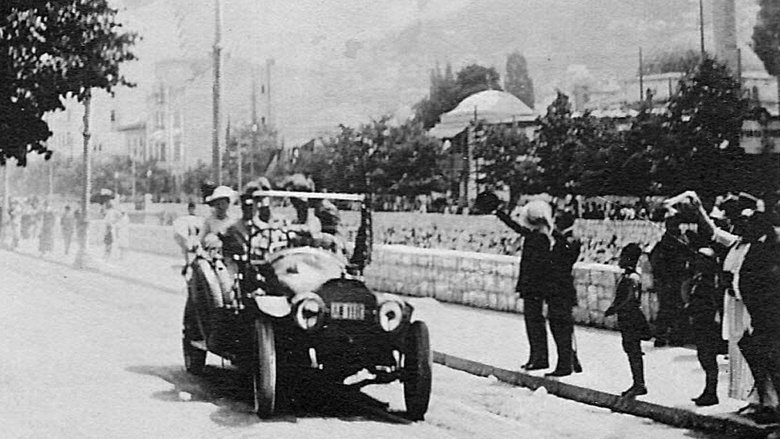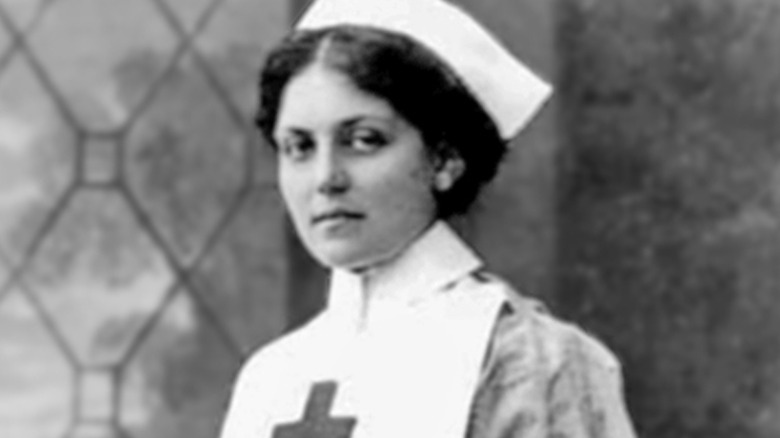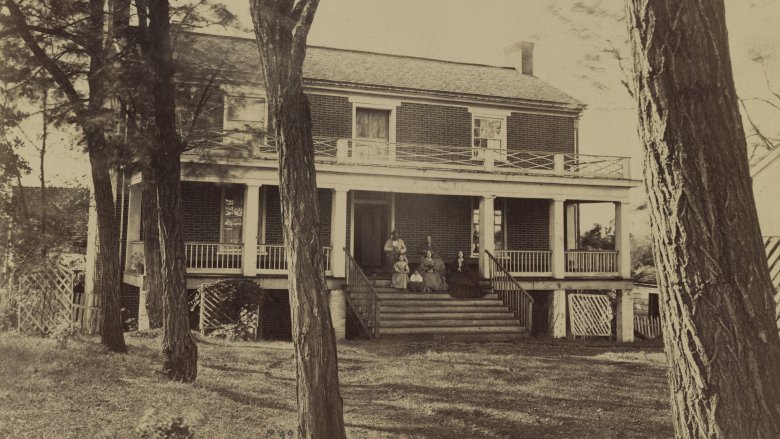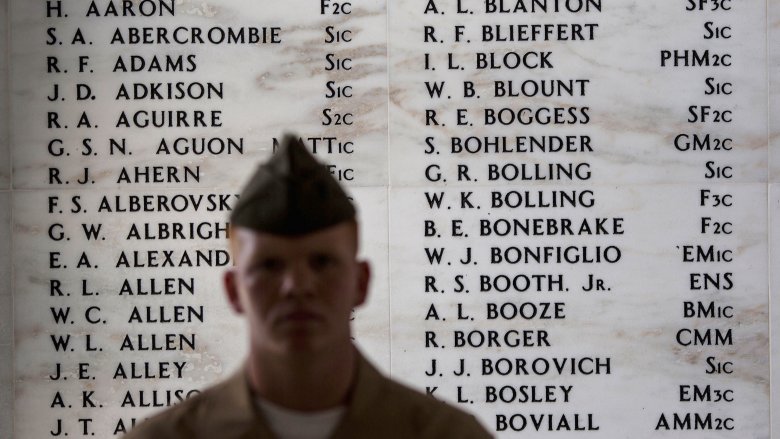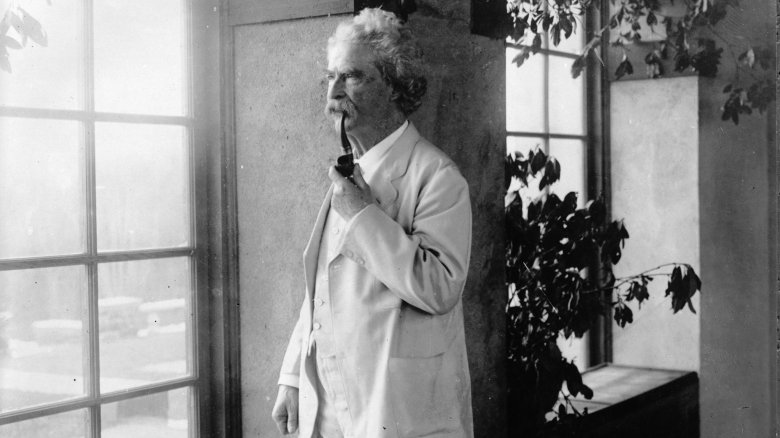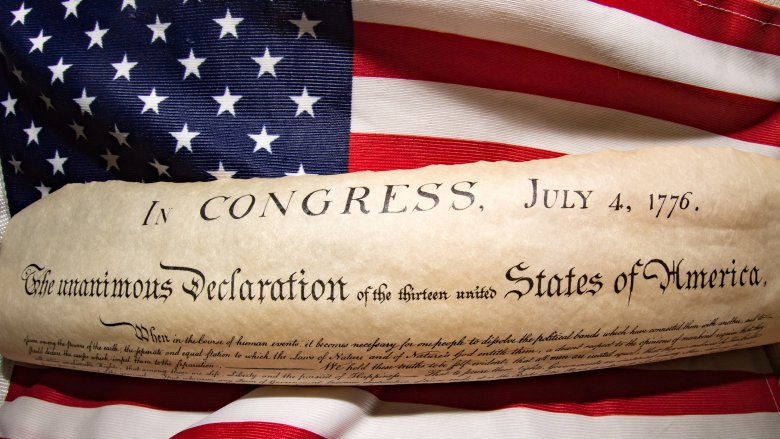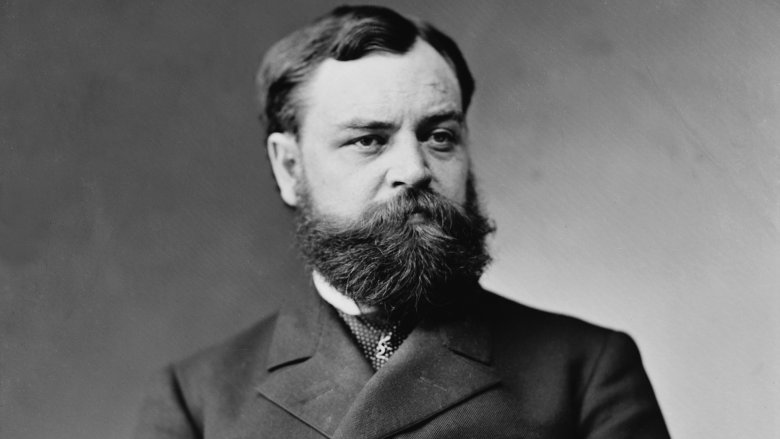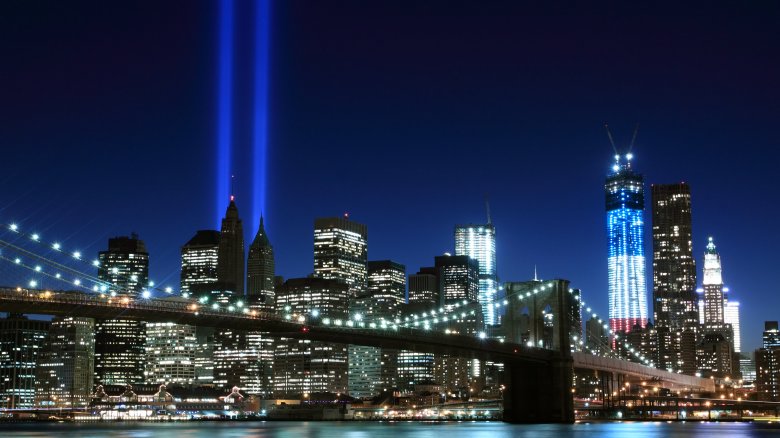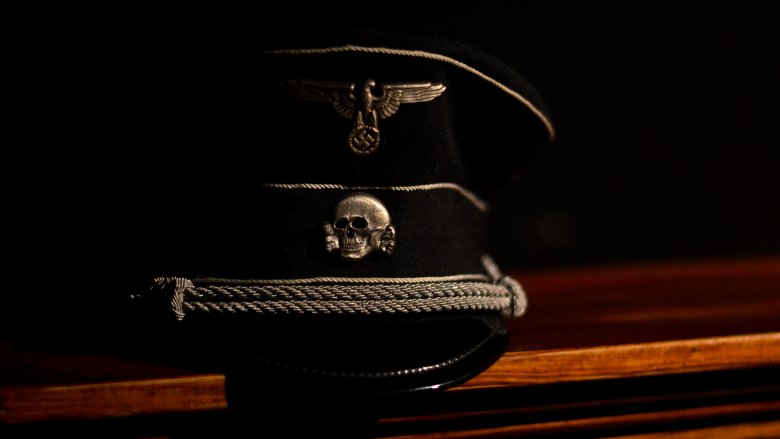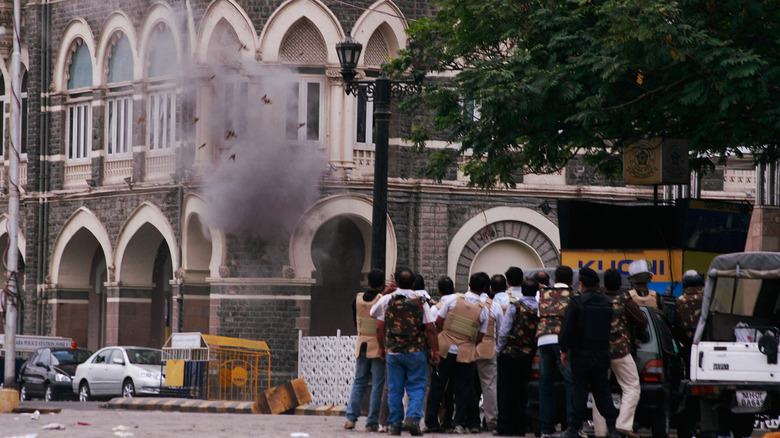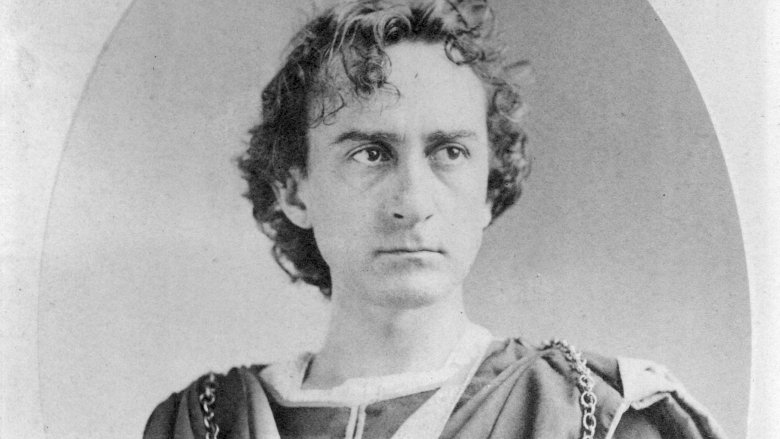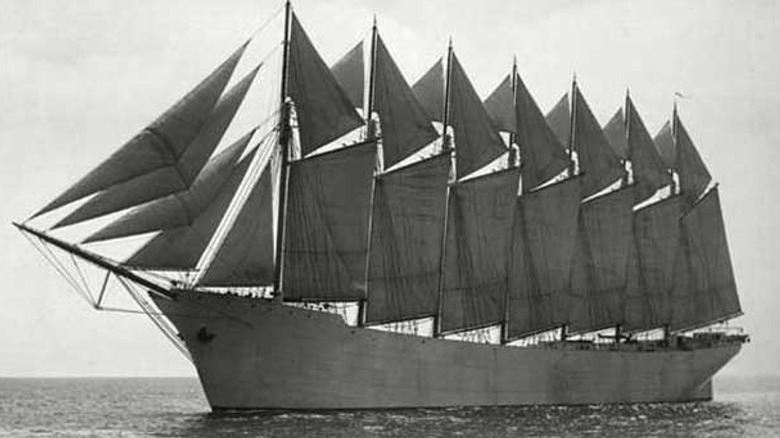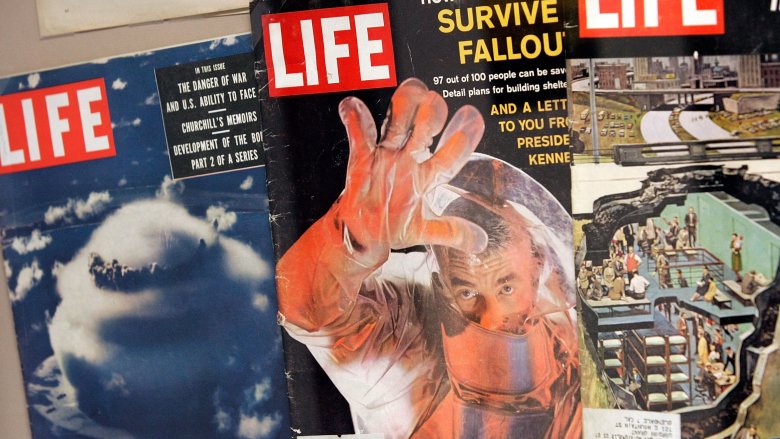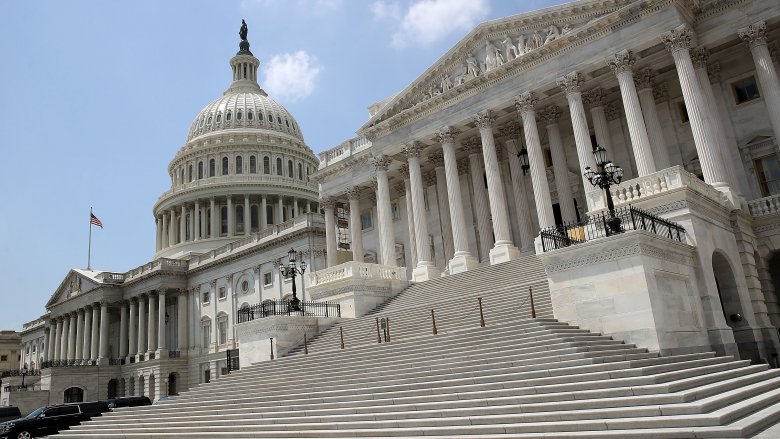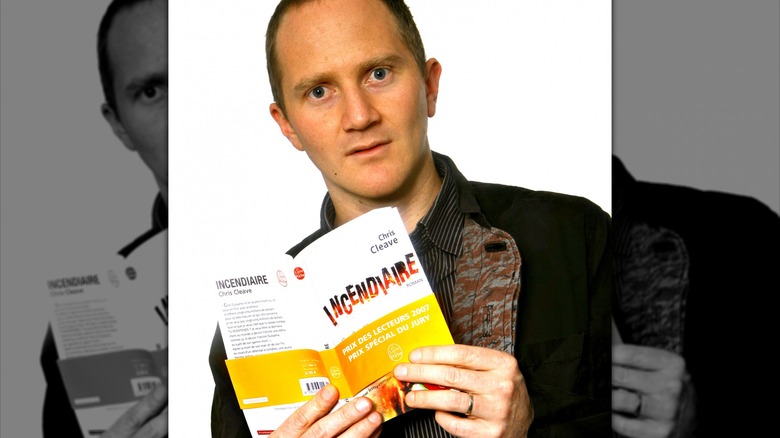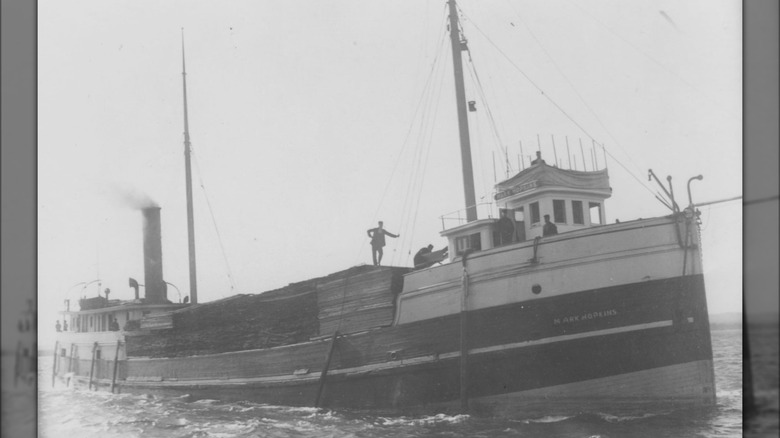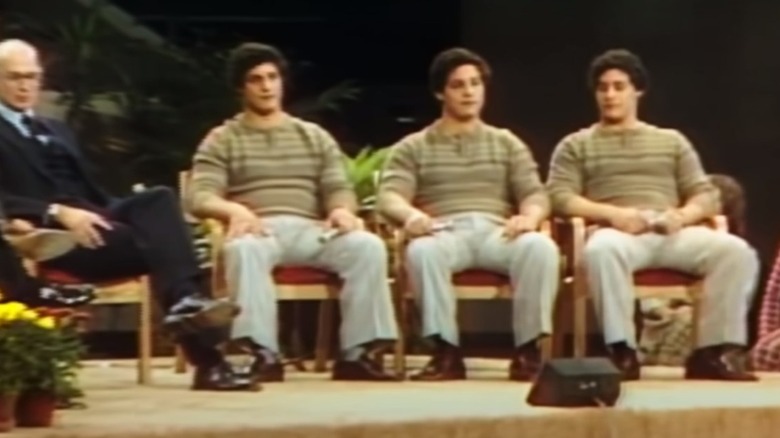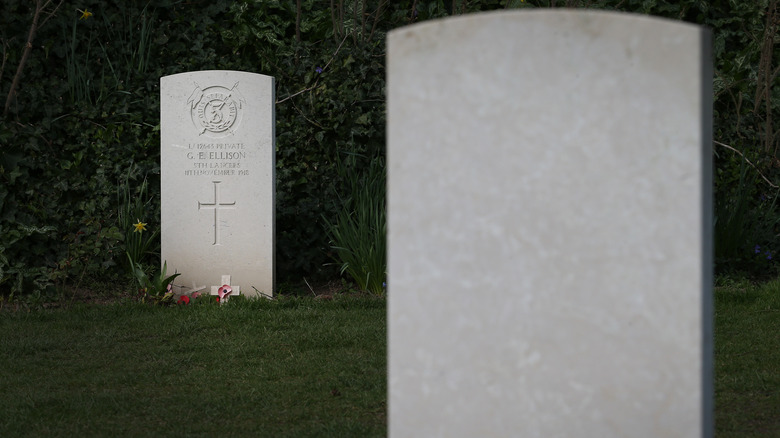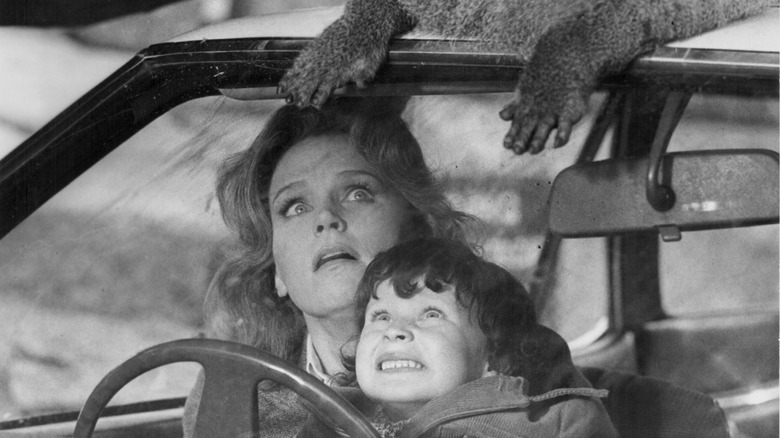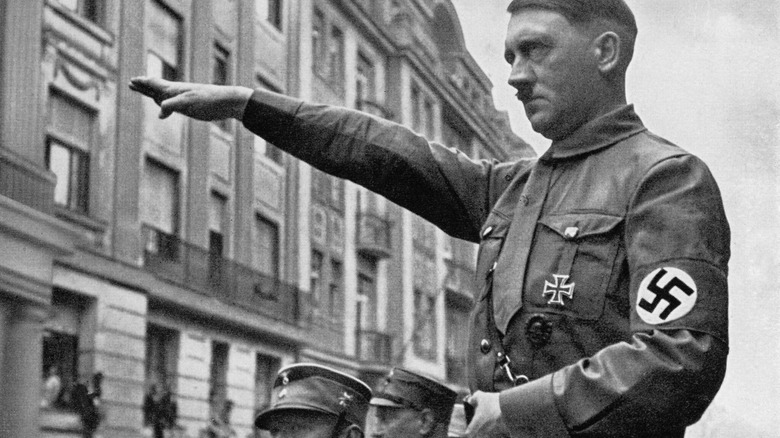Creepy Coincidences Guaranteed To Give You Chills
There's something comforting about the idea of things being orderly and predictable. The status quo. Unfortunately, life is all too often more like a Jackson Pollock painting: Random colors thrown at a canvas that make humankind think on their collective feet and say, "Well, I guess we're doing this now."
Every so often, though, there's something that jumps out from the chaos: coincidence. That's when events seem to align on an almost cosmic level, leaving those who witness said events wondering just what kind of guiding hand was involved in stirring the primordial juices to make things all sort of come together at that particular moment. Sometimes, coincidences are the funny sort of thing — sharing a birthday with a stranger, perhaps — that can be laughed at and shrugged off, but other times? Not so much.
Other times, they're downright creepy — and can send those very uncomfortable chills down your spine. Like when a set of seemingly impossible coincidences align so precisely that the entire thing feels like a setup from a bad piece of fiction. But it's not.
An Edgar Allan Poe story happens, 46 years after it's published
If you were to name which author's work you'd most want to come to life, you probably wouldn't go for Edgar Allan Poe.
His one and only full-length novel is "The Narrative of Arthur Gordon Pym of Nantucket," and here's the gist of the story: Pym is stowing away on a whaling ship, but things go sideways, and the crew mutinies. Almost everyone dies, a storm hits, and the remaining crew are left adrift. They catch, kill, and eat a turtle, but it's not enough. They draw straws to see who's going to get eaten, and the unfortunate man who draws the short straw is a mutineer named Richard Parker. He's killed, eaten, and ultimately, the remaining crew are rescued.
That was published in 1838, and in 1884, a ship called the Mignonette left England for Australia. There was no mutiny, but the yacht was hit by storms off the coast of Africa. The four men were left adrift in a dinghy with no food or water, but they did manage to catch, kill, and eat a turtle. Sounding familiar? Starving, they decided one of their number needed to die so the rest might live, and they settled on the youngest among them, mostly because he was sick from drinking seawater anyway, and he had no family to return to. He died, was eaten, and the others were rescued four days later, still munching on what remained of his body. His name? Richard Parker.
A set of identical twins are killed in separate accidents on the same road
Twins share a bond that's pretty mysterious to the rest of us, for better or worse. In 2002, two 70-year-old twin brothers died two hours apart, and that's not the really eerie part.
The first brother was riding his bike on a roadway north of Helsinki, when he was hit by a truck and killed. Before the family was even informed of his death, the second brother also died. He was riding his bike when he was hit by a truck and killed. The accidents happened on the same road, less than a mile apart, and the BBC quoted one of the Finnish police officers involved in the cases as saying, "This is simply a historic coincidence. Although the road is a busy one, accidents don't occur every day ... It made my hair stand on end when I heard the two were brothers, and identical twins at that. It came to mind that perhaps someone from upstairs had a say in this."
Chris Benoit's Wiki update
What happened to Chris Benoit and his family was nothing short of heartbreaking. In June 2007, news outlets were reporting on a bizarre scene that had played out in the wrestler's home that had ended with his suicide. Both his wife and son were also found in the house, also dead.
But 14 hours before their bodies were discovered by police, Benoit's Wikipedia page was updated to say that he'd been having difficulties because of "personal issues ... stemming from the death of his wife Nancy." The edit was reversed within the hour because there was no sourcing information, and the trolls, who were determined to continue with the joke that a normal person would realize isn't funny under any circumstances, reposted the claim with sourcing attributed to "several pro wrestling websites."
The first IP address came from Stamford, Connecticut, which also happens to be WWE headquarters, and the second came from Sydney, Australia. Atlanta police were informed about the edits and ultimately investigated the Benoit home after the WWE received some unsettling text messages. The Wiki user (who, frankly, should have known better) declined all interviews but did post an apology saying that the entire thing was "just a major coincidence" (via Wikinews) and that he'd made the random assertion on his own. We can only hope that the Internet learned a very important lesson from this one.
The accidental reveal of D-Day codenames
Leonard Dawe was just an ordinary guy with an ordinary job. He was the headmaster of the Strand School in Surrey, and he had one of the most seemingly harmless hobbies ever: he liked crosswords, so much that he'd been writing them for The Telegraph since they started running them in 1925. In June 1944, though, he was at work when a very official-looking car pulled up, and he was escorted out of the building by agents from MI5. He returned a few days later, refusing to say a word about what happened.
It wasn't until 1958 that he was allowed to tell his side of the story. You'll recognize the time that MI5 came knocking on his door as just before D-Day, and everyone was on edge. When one MI5 officer was trying to take his mind off the problems of the world by doing a little crossword puzzle-solving, he was concerned when he started finding words like "Utah," "Overlord," "Juno," "Omaha," "Neptune," and "Mulberry" in the puzzle because they were all code words for various parts of the D-Day plan, and they were right gosh darn there.
It turned out that Dawe wrote his crossword by giving his students blank layouts, asking them to fill in the words, and then writing the clues last of all. Unfortunately for him, the boys had been hanging out with some soldiers stationed nearby, and they had written down some of the cool words that they'd overheard. Whoops.
Irish couple Margaret and John Naylor die on the same day
At a glance, the gravestone looks like any other. It marks the final resting place of Margaret and John Naylor, an ordinary Irish couple who lived ordinary lives but died extraordinary deaths.
The First World War was just getting started. John Naylor joined the Royal Dublin Fusiliers and headed off to war. He left behind his wife, Margaret, and their three children, all under 6 years old. He was sent to the trenches in France, and on April 29, 1916, he died there. He wasn't the only one — the men in the trenches were gassed, and according to witnesses, their deaths were horrific.
Things weren't well back in Ireland, either, and if you're at all familiar with Irish history, you'll recognize the year as a landmark one in the Irish fight for independence. On the very same day her husband was dying in the trenches, Margaret left her Dublin home and braved chaos on the streets to buy bread for her children. She was shot once — in the head — as she crossed the Ringsend Drawbridge, and she became the very first woman to die during the Easter Week Rising. According to The Irish Times, she died not knowing that a bizarre coincidence had orphaned their children.
Predicting the Titanic
An "unsinkable" ship, described as "the largest craft afloat and the greatest of the works of men." A recovering alcoholic for a captain, a collision with an iceberg, and a catastrophic loss of life. We're not talking about the sinking of the Titanic — we're talking about the sinking of the Titan, and it happened in a 1898 novella by Morgan Robertson called Futility. There were so many similarities that Roberston had to insist he wasn't a clairvoyant, and while that's certainly creepy, we're not done yet.
The Titanic sank in 1912, and it made headlines across the globe. At the same time Titanic was setting sail on its ill-fated journey, Popular Mechanics published a short story by Thornton Jenkins Hains (writing as Mayn Clew Garnett). The tale was about an 800-foot luxury liner that collided with an iceberg while steaming across the Northern Atlantic at a speed of 22.5 knots. Casualties are steep because there aren't enough lifeboats. News of Titanic—an 882-foot liner that collided with its iceberg at 22.5 knots—appeared alongside the fictional tale.
And we're still not done. Twenty-six years before Titanic sank, British journalist WT Stead published the fictional "The Sinking of a Modern Liner." That ship was sailing from Liverpool to New York City when it sank, and again, casualties were high because of an insufficient number of lifeboats.
WT Stead was onboard Titanic and died in the icy waters of the Atlantic Ocean.
The license plate of the car that started World War I
In case you slept through this day in history class, a quick recap: One of the major events that kicked off the start of World War I was the assassination of Archduke Franz Ferdinand. It's one of those events that's become so mythic that a ton of rumors have grown up around it, like the idea that in 1913 he killed a white stag and was targeted by a legendary curse that said his own life was forfeit. We're not sure about that, but given that he kept records of his hunting kills and had ended the lives of 272,439 animals, Mother Nature might have wanted to have a little sit-down with him.
One of the strange coincidences that's absolutely true, though, is about his car. It was a Graf and Stift double phaeton, and while it wasn't the cursed car of death it was rumored to be, it did bear an odd message. The car ended up in the impossible-to-pronounce Heeregeschichtliches Museum of Vienna, where it sat for almost two decades before a British tourist pointed out the odd significance of the license plate. The plate — that hasn't been replaced and can be seen in photographs of the assassination — reads A 111 118 ... as in "Armistice, November 11, (19)18," the famous date of the agreement that ended World War I.
Violet Jessop survived three White Star tragedies at sea
In the early 20th century, luxury liners were the bee's knees. The White Star Line was one of the premiere ship-builders, and three of their biggest and best were the Olympic, Titanic, and Britannic. You know most of the story, but strangely, one woman was onboard every single one of them.
Her name was Violet Jessup, and she was an Irish nurse from Argentina. It started in 1911 when she was onboard the Olympic when it collided with the HMS Hawke. The Olympic didn't sink, but Jessop's friends convinced her that an even more incredible time was to be had working on Titanic ... so that's where she headed next, and she was one of the survivors pulled from the freezing Atlantic by the Carpathia.
Not to be deterred by something clearly trying to send her a message, she went back to sea to serve on White Star's Britannic, which was drafted into service as a hospital ship during World War I. That ship hit a mine, and Jessop found her way into the lifeboats yet again. This time, though, that lifeboat was dragged back toward the sinking ship and its propellers. Seeing other ill-fated lifeboats — and their passengers — chopped to bits by the propellers, she jumped, hitting her head hard enough that she would have headaches for the rest of her life.
You're guessing she swore off ships forever, right? You'd be wrong. She worked as a ship's stewardess until 1950.
America's Civil War started and ended with Wilmer McLean
Saying you were there for the first shot and the last shot of a war that ripped a country apart sounds like the kind of one-upmanship that only happens after the drinks have been flowing for a while, but in the case of Wilmer McLean, it's a totally legit claim.
In July 1861, McLean turned use of his Virginia home over to Gen. PGT Beauregard, who was gearing up for the First Battle of Bull Run when a cannon ball crashed through his kitchen. In his diary, the general wrote, "A comical effect of this artillery fight was the destruction of the dinner of myself and staff by a Federal shell that fell into the fire-place of my headquarters at the McLean House." We're tempted to suggest that McLean was less inclined to see the humor, but there you go.
Let's fast-forward a bit and follow McLean as he moved his family farther from the front lines and to a cottage in Appomattox County, where he was certain he was well away from the fighting. Yet not only was he right in the middle of the final skirmishes of a dying war, but when it came time for officials to choose a place for the end of the Civil War to be made official, they chose McLean's parlor. That was all well and good, but they didn't just sign documents, the men looted the house for souvenirs afterward. Talk about adding insult to injury.
An unfortunate advertisement seems to predict Pearl Harbor
The attack on Pearl Harbor on December 7, 1941, changed the course of World War II, and it definitely changed the United States' role in it. Global tensions were, of course, high, and it's terrifying to think that someone inside the country not only knew what was going to happen but was passing information out in the weirdest way possible.
The Pearl Harbor Visitors Center says that on November 22, 1941, the New Yorker ran a few ads for a dice game called The Deadly Double. Advertising is a product of the times, and these times dictated marketing the game with a major ad that showed the game being played by people hiding in an air raid shelter. Smaller ads also ran, and it wasn't until after the attack on Pearl Harbor that people started noticing what numbers were showing on the ads' dice, including one ad with dice that showed 12 and 7. Other ads supposedly bore numbers that referred to things like the time and latitude of the attack, and if you're thinking that military intelligence would be interested in something like this, they absolutely were ... but it was an unfortunate coincidence.
The theory was so widespread that The New York Times even ran a piece on the game's creator to debunk it, explaining that there was no actual link between the game and the war. The creator's wife got in touch with the paper to say as much, and it was eventually chalked up to a bit of coincidence and a lot of people's imaginations getting the better of them.
Mark Twain's connection to Halley's Comet
Halley's Comet buzzes by Earth once every 75 years or so, and it's crazy to think that it's been witnessed and recorded by skygazers as far back as 239 BC (via Space). It's appeared over epic events like William the Conqueror's invasion of England, and it's no wonder that people tend to think of the comet as heralding change. When it returned to our skies in 1835, it welcomed a change to the literary landscape: Mark Twain was born just two weeks after the comet had passed overhead.
The University of Houston's John H. Lienhard says that particular sign didn't go unnoticed either, least of all by Twain himself. Halley's Comet was getting ready to come around again when he wrote the ominously prophetic words, "I came in with Halley's Comet ... It is coming again ... and I expect to go out with it ... The Almighty has said, no doubt: 'Now here are these two unaccountable freaks; they came in together, they must go out together.'"
And that's exactly what happened. Halley's Comet reappeared the next year, and Twain died on April 21, 1910, just as the comet passed overhead. So, how about it: was it a bit of cosmic foreshadowing, an omen of change, or a spooky coincidence?
July 4 was a deadly day for the Founding Fathers
Ask any red-blooded American what July 4 is and you're bound to get an answer that involves something about independence, freedom, and the names of their own personal bald eagles. But July 4 has another weird significance that's usually overlooked in favor of the sorts of things you can cheer about while setting off fireworks: Founding Father fatalities.
Five of America's Founding Fathers served as presidents: James Madison, John Adams, George Washington, Thomas Jefferson, and James Monroe. The weird part? Three of them died on the same date: July 4. And it gets weirder.
Jefferson and Adams both died on the exact same day: July 4, 1826, which you'll recognize as significant if you're a math whiz, because it's the 50th anniversary of the signing of the Declaration of Independence. According to the Constitution Center, the coincidence didn't go unnoticed as it happened, and when Daniel Webster wrote a joint eulogy for them, he said, "It cannot but seem striking and extraordinary, that these two should live to see the fiftieth year from the date of that act, [and] the heavens should open to receive them both at once."
Only a few years later, James Monroe died on July 4, 1831. Don't forget that Monroe was only the country's fifth president, meaning that when he died (during the term of Andrew Jackson, the seventh and most badass president), that meant not only had three of seven died on the same date, but they'd died on their country's birthday. That's enough to make anyone believe in signs.
Robert Todd Lincoln was closely connected to three presidential assassinations
Robert Todd Lincoln — President Abraham Lincoln's oldest son — was an iconic figure. There's been plenty written about his father, but far less about RTL himself. That's a shame, too, because his life is just as fascinating as his dad's. For instance, Robert Todd Lincoln was tragically up close and personal for no fewer than three presidential assassinations. The Blog of the James A. Garfield National Historic Site gives a great rundown on why Robert Todd always felt like he was cursed. Things started first with the infamous assassination of his own father. He was supposed to be at Ford's Theater the night John Wilkes Booth would pull the trigger but told his parents he was going to turn in early instead. He was at the president's side when he died the next morning.
In 1881, the younger Lincoln accepted a position as Secretary of War for President James Garfield. Soon after, Garfield was shot at the Baltimore and Potomac train station in Washington DC on July 2, 1881. Lincoln was walking about 40 feet behind the President when it happened, and Garfield died from his injuries 80 days later.
Lincoln gave up political service and became president of the Pullman Palace Car Company. In 1901, he and his family decided to visit Buffalo, New York's Pan-American Exposition. He got off the train and was handed a telegram: President William McKinley had just been shot — at the Pan-American Exposition in Buffalo.
There's a tenuous link to a fourth presidential death, too, as his final public appearance was at the dedication of the Lincoln Memorial. President Warren Harding conducted the ceremony ... and he died 14 months later. Even if you don't count Harding, three presidents in 36 years would have the biggest skeptic thinking twice about who he's hanging out with.
9/11 pop culture coincidences
There are plenty of conspiracy theories suggesting the U.S. government had advance knowledge of what was going to happen on September 11, 2001, just as there are plenty of reasons conspiracy theorists are generally regarded as loony. But some pop culture coincidences are enough to make you wonder if something out there in the universe was trying to tip us off.
The first is hidden in a video game called "Deus Ex." The game came out in 2000, and the story takes you to New York City. Take a gander at the skyline, and you'll notice two buildings are conspicuously missing: the Twin Towers. Even stranger, the game's lore acknowledges it, saying they were destroyed by terrorists. What? According to Kotaku, they were excluded from the skyline because of memory constraints, but still.
If that's not weird enough, let's talk about Dream Theater. The band was in New York at the time of the attack, and it also happened to be releasing its album "Live Scenes From New York." The album hit stores on September 11, 2001, and the cover featured an apple, the Statue of Liberty, and the Twin Towers ... all on fire. Live scenes, indeed. When NoiseCreep spoke to Dream Theater's Mike Portnoy, he called it "one of the strangest coincidences of my career."
November 9 is a weirdly significant date in German history
True, there are only 365 possible dates for any given event in the modern era, but the fact that six monumental events in German history have taken place on November 9 is enough of a coincidence that the whole country should be eyeballing the calendar every time it rolls around.
ThoughtCo took a look at the specifics, and it's staggeringly creepy just how many nation-changing events happened on that day. It started in 1848 with the execution of Robert Blum. You might not know the name, but he was a crusader for establishing democracy throughout the German-speaking world. Fast-forward a bit to November 9, 1918, and Germany's first democracy — the Weimar Republic — was established. Fine, fine, two events don't make a pattern. On November 9, 1923, Adolf Hitler and his followers tried to overthrow the Weimar Republic with their Bierkellerputsch, and while that failed, we all know what happened to Hitler next. Two years later — also on November 9 — he founded the elite SS force.
The German hits just keep on coming. November 9, 1938, was known as Kristallnacht ("Night of Broken Glass"), when the Nazis unleashed hell on Jews across the country. It's one of the most notorious dates in German history, and it's also the day the Berlin Wall fell in 1989. The fall of the Berlin Wall is the kind of thing you could make a national holiday out of in Germany, but it'd be tough with all the horrible things that also happened on November 9.
One U.K. couple managed to vacation during three separate terrorist attacks
What's the worst thing you can imagine happening to you while you're on vacation? Having all your luggage lost, maybe, or coming down with some exotic sort of stomach bug? One British couple puts all your vacation nightmares to shame.
According to The Telegraph India, it started when Jason and Jenny Cairns-Lawrence were vacationing in New York City on September 11, 2001. You recognize the date, of course, as the day of the terrorist attacks on the World Trade Center. They weren't among the thousands of casualties, but when it came time to pick their next vacation, they decided to stay a little closer to their Birmingham, England home. They chose London, and on July 7, 2005, they were in the nation's capital when four suicide bombers killed dozens and injured hundreds of people on the London Underground.
Then, in 2008, they were faced with making a vacation choice again. They headed to Mumbai ... and they were staying in the Colaba area when terrorists attacked the city on November 26, killing almost 180 people. In a horrible series of coincidences, the Cairns-Lawrences managed to have front-row seats in three of the world's worst terrorist attacks in recent history and gave first-hand reports of the fear — and resilience — they saw in each scene. It's a terrifying, 21st-century reality that no one wants to face, but they did. Three times.
Edwin Booth saves Robert Todd Lincoln
Everyone knows what ultimately happened to Abraham Lincoln. (We're referring to his assassination by John Wilkes Booth, just to be clear.) But the Lincoln family and the Booth family overlapped in other, strange ways.
About a year before Abraham Lincoln was shot, his son Robert Todd Lincoln was standing on a crowded train platform in Jersey City. According to The New York Times, Robert fell in front of an approaching train and would have died had a man not grabbed him and hauled him to safety. When he turned to look, he recognized the man as actor Edwin Booth. The Times quotes Lincoln as writing, "I expressed my gratitude to him, and in doing so, called him by name."
Booth, however, didn't recognize the president's son. It was only later that he received a letter from a friend who was serving alongside Robert, telling Booth he'd saved the life of the younger Lincoln. That letter came from Colonel Adam Badeau. Of course, Badeau almost wasn't around to send that letter, as he'd nearly died in the middle of the anti-draft riots that had swept across New York in 1863. The man who saved his life? John Wilkes Booth.
The sinking of the Lawson
Don't recognize Thomas W. Lawson's name? You probably shouldn't, but now you'll think of him every time Friday the 13th rolls around.
According to LiveScience, Thomas W. Lawson was a British stockbroker, and in 1907 he published a book called "Friday the Thirteenth." It's the story of (surprise) a stockbroker who tries to make the entire market crash on (also surprise) Friday the 13th. It was a big deal at the time. Pretty straightforward, right?
His book was published five years after the construction of a schooner named the Thomas W. Lawson (after a different guy), and the ship spent some time sailing the U.S. coasts. It wasn't until after she was re-outfitted that she made her first transatlantic voyage. According to Ocean Navigator, she sank on Hellweather Reef (shudder) off England's Scilly Islands, claiming the lives of 17 people. The date? Friday, December 13, 1907.
Life magazine's beginning and end
Life is one of the most iconic magazines of the 20th century, and its covers feature plenty of defining moments. There's a less well-known photo that seems to have defined the life of one man in particular: George Story.
According to David E. Sumner, a journalism professor at Ball State University, the very first issue of Life hit the stands on November 23, 1936. There was a photo of Montana's Fort Peck Dam on the front, and on the inside, the very first photo was of a baby being cradled in a doctor's hands. That baby was George Story, and the caption read, "'Life' begins."
Story went on to become a journalist, but that's not the big coincidence here. On April 4, 2000, Life announced it was ceasing publication. With the announcement of the end of Life also came the end of Story's life — he died only a few days later of heart failure at age 63.
A tornado saves the Capitol from being burned
Schools teach you all kinds of things about the American Revolution, but they seem to sort of gloss over the War of 1812 en route to the Civil War. That's a shame because something strange happened as the British marched on Washington, D.C., and it's some serious hand-of-God stuff.
It was August 25, 1814. The British were marching on Washington, President James Madison and wife Dolley were getting ready to leave town, and the fast-approaching soldiers were getting their torches ready. According to The Smithsonian, the day was insanely hot, with temperatures reaching 100 degrees. By the time the British started setting fires, it was even hotter on the streets of the young city. Things were going badly, but that's when the tornado hit. It formed right in the middle of the city, hitting British troops on their way to Capitol Hill, killing countless men, and tossing cannons aside like toys.
The tornado brought a thunderstorm that lasted for a few hours and put out all the fires the British had started. Not only did the storm halt a lot of the damage that could have been done, but British forces abandoned the city after only 26 hours. Coincidence or a divine hand?
A terrorist attack coincided with the release of a novel... about a terrorist attack
It's every writer's dream to have their first book published, whether it's a non-fiction deep dive into something obscure, or fluffy light reading. Chris Cleave's debut was neither: "Incendiary" is a heartbreaking book about a mother grieving the loss of her husband and sons during a terrorist attack on London. It was released on July 7, 2005 — and that just happened to be the day that four suicide bombers detonated bombs in London's Underground and on a bus, killing 52 and wounding countless more.
Cleave has spoken about his absolute horror at seeing a very real terrorist attack unfolding in his city, telling NPR, "As the injured started to pour out of the Tube and concerned friends began to ring, I realized this is really happened. I wondered if, by some kind of awful magic, I had caused this thing to happen. By imagining a terrorist attack so vividly in my book, had I made it come to pass?"
Hindsight, Cleave later wrote, was pretty terrible — especially when it came to posters that had been put up in the Underground, depicting London's burning with the words, "What If?" "I cringe to remember it. My god — really — what were we thinking?" he wrote on his blog. The book had come together the previous year, and while Cleave said he had been inspired by the world that his son had just been born into, his book paled in comparison to the real-life horrors.
The day the grizzlies attacked
It's one of the great mysteries of life: If bears aren't friends, then why are they friend-shaped? Bears might be fluffy and cute, but they're definitely not friends — and it was on one night in 1967 that a bizarre set of coincidences proved that beyond a shadow of a doubt.
The setting? August 12, 1967, in two entirely different areas of Glacier National Park. The culprits? Two very different bears. The victims? Two girls, both on a camping trip, and both were 19 years old. Michele Koons was camping with friends, and a bear showed up in camp in the middle of the night. She was trapped in her sleeping bag, and the others were forced to listen as she was torn apart. Later park rangers shot and killed a bear that had been acting strangely and confirmed it was the killer — blonde hair was found in the bear's stomach. The same night, Julie Helgeson was camping with a friend when they were attacked. She was dragged away, and although she was alive when rescuers found her, she died from her injuries.
Coincidence, perhaps, but according to what former ranger Dave Shea told the Great Falls Tribune, not entirely surprising. Not only was the first bear known to regularly approach people, but it was clearly sick. Add in all the garbage that was littering the park — often placed deliberately to lure bears to within gawking range of tourists. Shea said, "Obviously they weren't being treated with the right respect."
The fates of the SS Myron and SV Miztec
So here's a weird one, and it starts with the tragic story of the SS Myron (pictured). Captain Walter R. Neal was at the helm when the ship set off across the Great Lakes on November 22, 1919 — and as Gordon Lightfoot fans know, that's a terrible time to be sailing the Great Lakes. She was heading for Buffalo, New York, and had another ship in tow — the Miztec.
The Myron and the Miztec got into some serious trouble during a storm, and after cutting the Miztec free, the Myron continued to flounder before sinking. Neal stayed aboard, and despite rescue attempts, the Myron's entire crew perished ... except for Neal, who survived when the pilot house broke free of the doomed ship. The Miztec, meanwhile, stayed afloat.
Neal had some very, very strong words for those who had failed to help his struggling ship, and after some shocking accusations were made and licenses were revoked, he ended up on the waters of the Great Lakes again. This time, he was the first mate on a ship called the Zillah, and in 1921, the Zillah was back in the same place that the Myron sank. Also there? The Miztec. When a springtime storm moved through — it was May — the Miztec sank just a stone's throw from the wreck of the Myron, losing all hands under the watchful eye of the former captain. The date? Friday the 13th.
Two related deaths at the Hoover Dam
The story starts with J.G. Tierney, a miner born in 1885. He traveled across the American West, until he finally ended up working on a massive project — building a new dam along the Colorado River. He worked with the scout party who was looking for the best location to build. Nevada State Museum historian Dennis McBride explained to the Las Vegas Review-Journal that it would have been a dangerous job: "The Colorado was just an unfettered river all the way from the Grand Canyon to Yuma. It would have been a wild river with terrific flooding."
It was during one of those floods that J.G. Tierney was killed. He became one of the first to die building what would become the Hoover Dam. The date? December 20, 1921.
His body was never recovered, and his grieving widow never stopped inquiring every time remains were found. She and her young son ended up moving to Missouri, where he grew up, got married, and had a child of his own. By that time, the Great Depression was in full swing, and desperate to find work and support his family, Patrick Tierney moved westward. Against the wishes of his mother, he got a job working as an electrician on the Hoover Dam project. It turns out that sometimes, mothers do know best: Patrick was killed when he fell from one of the dam's towers. The date? December 20, 1935 — 14 years to the day that his father had died on the same project.
A chance meeting revealed a bizarrely cruel social experiment
Leaving the safety of home and heading off to college can be a life-changing event, but for Robert Shafran and Eddy Galland, their completely random choice to start at New York's Sullivan County Community College was life-changing in a way that no one could even begin to imagine. They enrolled a year apart, and when Shafran got there to find that everyone seemed to already know him, he was shocked. He finally figured out that there was a student who looked just like him, so he went to meet Galland. They were twins, separated at birth. But that wasn't the whole story.
The chance meeting got some media attention, and it got the attention of David Kellman. He also looked exactly the same: They were actually triplets. The story is impressive — and unlikely — enough with just the coincidental crossing of paths, but that's not the end, either.
The triplets later learned that they were separated at birth and placed with adoptive families through an adoption agency in a process that was overseen by two psychiatrists. They were running a study on nature versus nurture and placed the brothers in families of specific and different socio-economic standings. What did they learn? Well, for starters, it's incredibly traumatic: Galland died by suicide in 1995, and the remaining two brothers have spoken about their mental health issues stemming from the discovery and fallout. Also? They were just one set of many sets of twins and triplets who were a part of the experiment.
The first and last British casualties of World War I
The Symphorien military cemetery in Belgium hosts two adjacent graves that mark the final resting place of both the first and the last British soldier to die in the war. Their graves are separated by only 7 yards. Not only was it a complete accident, but it went unnoticed for decades.
The first was Pvt. John Parr, a London teenager who joined the military at 14 and was sent to northern France. It's unclear just how he died, but records do show that he was a bicycle scout, and it's believed he was killed by a German cavalry patrol on August 21, 1914 — 17 days after the war started. The last was Pvt. George Ellison, who was also shot and killed while on patrol. He had enlisted, served his time, and moved on to family life as a coal miner before being re-drafted into military service, serving a brutal four years, and dying just 90 minutes before the armistice began at 11 a.m. on November 11, 1918.
And yes, it's totally random. Parr was actually buried there by German soldiers and not until 1915. Ellison's final resting place is actually his second one, and it wasn't until the Imperial War Graves Commission started overseeing the proper burial of British soldiers in the 1920s that he was laid to rest there.
The Omen's cursed film set?
There's an old saying that lightning never strikes twice, but it turns out that it does ... at least, it did while production crews were trying to film a movie about an unsuspecting couple raising the Antichrist. Technically, it struck four times: Lightning hit the planes of Gregory Peck, executive producer Mace Neufeld, and writer David Seltzer in separate incidents ... and narrowly missed producer Harvey Bernhard. Weird? Hold this proverbial beer.
There were also two near-misses related to bombings; one at a hotel a director was staying at, and another at a restaurant where senior crew had planned to dine. Then, there was the weird number of animal-related incidents: At least one person was injured when the film's Rottweilers attacked, and that baboon scene? Completely real. One of the trainers was killed by a tiger, the day after filming that scene. Oh, and back on the subject of planes, one that was nearly chartered for Peck ended up not being needed at the last moment, which was a good thing ... it crashed, killed everyone on board, and people in a car on the ground — who just happened to be the family of the plane's pilot.
The film's Damien, of course, famously kills those he doesn't like. That included David Warner's character, who is beheaded in one of the greatest horror movie death scenes of all. A beheading death really did happen: On Friday, August 13, 1976, the movie's special effect designer was driving with his assistant, Liz Moore. There was an accident, and she was decapitated. The location of said accident — 66.6 kilometers from a town in the Netherlands called Ommen.
Eclipses are complete coincidences that occasionally change history
Eclipses are pretty neat, and it's easy to see how they might be pretty terrifying. They've been mentioned in the historical record for a long, long time, and there have been a few times that they've changed the course of history. The ancient Greek historian Herodotus wrote that a sudden eclipse led to the end of a six-year war between the Lydians and the Medes, and later astronomers identified the likely eclipse he was talking about. Neat, right?
Christopher Columbus, too, used his knowledge of an upcoming eclipse to threaten Indigenous Jamaicans into helping the interloping Europeans, and, of course, it worked in his favor. But here's the really wild thing: Eclipses happen because of a very, very likely set of coincidences.
Mark Gallaway of the University of Hertfordshire explained to LiveScience, "The [diameter of the] moon is almost exactly 400 [times] smaller than the sun's diameter, and the sun is almost exactly 400 times further away than the moon. The consequence of this is that the angular diameter, or size we see, of the sun and the moon in the sky are almost exactly the same." Factor in the movement of the bodies involved, and it gets weirder: That perfect alignment didn't happen millions of years ago, and it won't be the case millions of years from now. That humankind existed at the precise slice of history to be inspired by this randomly perfect alignment? Coincidence.
Adolf Hitler's life was saved a shocking number of times
Adolf Hitler famously boasted that his life was once spared by a British soldier named Henry Tandey. The story doesn't stand up to scrutiny, but what is true is that he had his life saved an almost ridiculous number of times — starting when he was 4 years old.
That's when a priest named Johann Kuehberger plucked a toddler named Adolf from a freezing river in Passau, Germany ... and that was just the start. Through a long series of strange events, an Irish man named Michael Keogh found himself joining the German army and crossing paths with LCpl. Adolf Hitler. They were in the barracks in Munich when Hitler found himself on the receiving end of an angry mob out for blood, and Keogh saved him. He ended up heading back to Ireland, but according to the Irish Independent, his decision haunted him: "If we'd been a few minutes later, or Hitler had got a few more kicks to his old wounds, or he'd been shot — what would have happened if we hadn't intervened and he'd died?"
In 1923, a woman named Helene Hanfstaengl found herself alone with the distraught Hitler after the Beer Hall Putsch, his attempt to overthrow the German government in November of that year. He was contemplating suicide when she took his gun away and talked him out of it. Then, in 1931, Hitler escaped death yet again when he was involved in a car accident in Munich. And that's not counting the whopping 42 assassination attempts that he survived.
